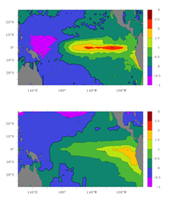War Pandemics and Climate the 1918 El Niño
Let me tell you a tale of war, influenza, and strange climate events that are sure to set your hair on end. But this is not a fictional story to scare and entertain; it is a historical reality that, with the work of scientists at the University of Colorado, Boulder, Texas A&M University, and the University of Maryland has been clearly established.
The story begins in late 1917. The Great War was dragging into its fourth year in Europe and Russia. An influenza pandemic began draping a curtain of death across the world. Four countries became embroiled in revolutions, and India experienced the worst drought on record. This last event--and perhaps some of the others--may have been influenced by an inconspicuous warm patch of water in the central equatorial Pacific Ocean, where a strong El Niño began to brew.
El Niño is short-hand term for a broader scientific phenomenon called El Niño Southern Oscillation (ENSO). These events are characterized by unusual weather patterns transmitted across the globe through the ocean and atmosphere. In short, ENSO events jumble weather patterns around the planet bringing some regions prolonged drought while other areas experience intense rainfall. The events are also felt in the ocean by uncharacteristic sea surface temperatures that send fish and other organisms skittering around the ocean in search of food.
Gil Compo, Jeff Whitaker, Prashant Sardeshmukh and their team at the University of Colorado and National Oceanic and Atmospheric Administration began by reconstructing atmospheric conditions around the globe for the past 100 years in the 20th Century Reanalysis Project. “Using U.S. Department of Energy supercomputers at NERSC,” says Compo, “we recreated the winds and atmospheric fluxes every six hours using surface pressure observations.”
 Photo credit: Gil Compo
Photo credit: Gil Compo
Computer simulations of sea surface temperature.
With these new atmospheric data, their colleagues at the University of Maryland and Texas A&M University, led by Ben Giese, reexamined sea surface temperatures (SST) in the Pacific Ocean based on the atmospheric reanalysis by simulating the associated ocean conditions. What popped out of the ocean data was a strong El Niño for 1918 in the equatorial Pacific. “It was apparent that this particular event was outstanding compared to what was available with past ocean reconstructions,” said Compo. He may not have gone looking for an El Niño story, but one found him.
Previous reconstructions of ocean conditions of this time period suggest a weak El Niño in 1918. Compo contends the previous reconstructions rely on a limited dataset resulting from reduced ship traffic in the Pacific Ocean during the war and the assumption that a strong El Niño event will produce changes in sea surface temperature along the western coast of South America.
“There are actually several flavors of El Niño,” begins Compo. “The classic example is characterized by warm waters off the coast of South America around Christmas time, hence the name El Niño-the boy or Christ child. But there are other kinds of El Niño.” Compo continues, “The warm waters associated with an El Niño can also occur in the central or western Pacific Ocean. Warming of surface water in the central Pacific Ocean has been strongly tied to weakened monsoons resulting in drought conditions in India.”
The ocean study was focused on a section of ocean in the Central Pacific ocean called Niño-3.4. This region is significant because it is an indicator of El Niño conditions. Compo explains, “When the temperature in Niño-3.4 is warm you safely say you have El Niño conditions. If the temperature is cold you have La Nina (the opposite of El Niño) conditions.” The ocean simulation strongly supported an intense 1918 El Niño event.
The team wanted independent support for their findings, so they turned to an ocean coral record obtained from the Maiana Atoll in the central Equatorial Pacific Ocean. Ocean coral produce a skeleton made from calcium carbonate (CaCO3). Scientists examine oxygen isotopes in the calcium carbonate to understand how ocean water salinity and temperature changed through time. Even subtle changes caused by El Niño events are recorded by corals. Compo’s coral records support the strong 1918 El Niño event suggested by the atmospheric reconstruction and ocean SST simulation.
 Photo credit: Gil Compo
Photo credit: Gil Compo
Gil Compo
“The coral record provides independent evidence that 1918 El Niño event was large and strong, similar to the simulations,” said Compo. “Even better, the corals were never used in any of the past SST reconstructions or in the 20th century atmospheric reanalysis, so it is completely unbiased.”
Compo concludes, “We need to know better what El Niño was doing in the past to improve our ability to simulate El Niño conditions so we can predict how it may change under warmer global conditions.” Compo and his team are working with international and domestic partners, including the NOAA Climate Database Modernization Program (CDMP), and the international Atmospheric Circulation Reconstruction over the Earth (ACER) initiative, to develop the most comprehensive historical datasets available.
Atmospheric reconstruction simulation computer hours were conducted through the Innovative and Novel Computational Impact on Theory and Experiment (INCITE) program sponsored by the Office of Advanced Scientific Computing Research within the DOE Office of Science. Funding for this research was provided by the National Oceanic and Atmospheric Administration and the National Science Foundation.
This article was written by Stacy W. Kish

